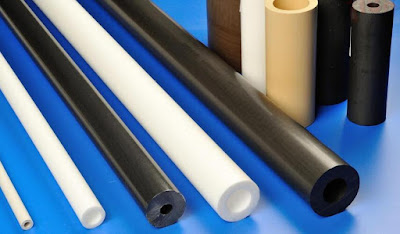Thread seal tape (also known as
PTFE tape or plumber's tape) is a polytetrafluoroethylene (PTFE) film for use in sealing pipe threads. The tape is sold cut to specific widths and wound on a spool, making it easy to wind around pipe threads. It is also known by the genericised trade-name Teflon tape; while Teflon is in fact identical to PTFE, Chemours (the trade-mark holders) consider this usage incorrect, especially as they no longer manufacture Teflon in tape form.Thread seal tape lubricates allowing for a deeper seating of the threads, and it helps prevent the threads from seizing when being unscrewed.The tape also works as a deformable filler and thread lubricant, helping to seal the joint without hardening or making it more difficult to tighten, and instead making it easier to tighten.
Typically the tape is wrapped around a pipe's thread three times before it is screwed into place. It is commonly used commercially in applications including pressurized water systems, central heating systems, and air compression equipment.
Types:Thread seal tape used in plumbing applications is most commonly white, but it is also available in various colors. It is often used to correspond to color coded pipelines (US, Canada, Australia and New Zealand: yellow for natural gas, green for oxygen, etc.). These color-codes for thread sealing tape were introduced by Bill Bentley of Unasco Pty Ltd in the 1970s. In the UK, tape is used from coloured reels, e.g. yellow reels for gas, green for potable water.
- White – used on NPT threads up to 3/8 inch
- Yellow – used on NPT threads 1/2 inch to 2 inch, often labeled "gas tape"
- Pink – used on NPT threads 1/2 inch to 2 inch, safe for propane and other hydrocarbon fuels
- Green – oil-free PTFE used on oxygen lines and some specific medical gasses
- Gray – contains nickel, anti-seizing, anti-galling and anti-corrosion, used for stainless pipes
- Copper – contains copper granules and is certified as a thread lubricant but not a sealer
Uses:Thread tape is appropriate for use on tapered threads, where the sealing force is a wedge action. Parallel threads may not seal effectively with or without tape, as they are intended to be sealed by a gasket.
Thread sealing tape is almost entirely applied by hand, although at least one machine is available for production wrapping of fittings.
PTFE tape is also commonly used in the stretching of body piercings, through a process known as taping, because it is inert and safe for this use. The wearer wraps layers of the tape around a plug, slowly increasing the size and thus slowly increasing the size (gauge) of the piercing.























